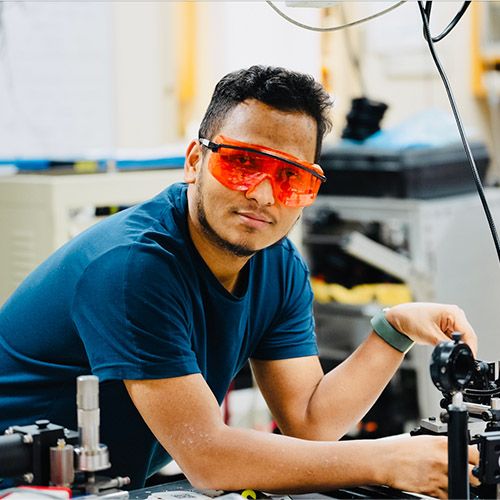Gautam Laboratory for Advanced Aerosol Dynamics
and Light Scattering Research
785.317.7470

Principal Investigator: Prakash Gautam, Ph.D.
Dr. Gautam is engaged in research combining experimental and theoretical aspects of electromagnetic and light scattering, particularly in atmospheric, climate, and colloid physics. His work involves designing and developing an angularly resolved, multi-angle light scattering setup for real-time, in situ characterization of the optical properties of aerosol particles, along with their identification and tracking. Optical properties include phase function, extinction (scattering + absorption), asymmetry parameter, albedo, lidar ratio, linear depolarization ratio (LDR), and other scattering matrix elements. His recent research has been particularly focused on the development of several key instruments and concepts: 1) a cost-effective sensor for monitoring ambient particulate matter using near-forward scattering, 2) a polar nephelometer capable of measuring light scattering from an extreme forward scattering angle to near exact backscattering angle, 3) theoretical and experimental analysis of the sensitivity of key backscattering phenomena in relation to particle microphysical properties such as size/size distribution, shape, and complex refractive index, 4) the optical properties of soot in various stages of aging, including soot coated with sulfate and other organic materials; and 5) optimizing current aerosol measurement technologies, such as integrating nephelometers by incorporating novel optical schemes.
Before joining DRI, Dr. Gautam was a PhD student at the Department of Physics, Kansas State University, where he designed and built an angularly resolved multi-angle light scattering setup capable of measuring scattered light from extreme forward angles (0.32°) to backscatter (178.6°), using an innovative optical design. He used this system to study the optical properties of aerosol particles with diverse sizes, shapes, and complex refractive indices. Additionally, Dr. Gautam explored the correlation between light scattering-derived particle sizes and those measured by commercial aerosol instruments, such as an Aerodynamic Particle Sizer (APS). His research also involved microphysical characterization of aerosol particles through techniques including transmission/scanning electron microscopy (TEM/SEM), X-ray diffraction (XRD), and Ultra-Small Angle X-ray Scattering (USAXS). He has developed extensive expertise in laser systems, optics, holography technique, and characterizaing particles from sub- to super-micron scales.
Contact: Prakash.Gautam@www-dev.dri.edu or (1)785-317-7470
Desert Research Institute (DRI) and University of Nevada, Reno (UNR), Nevada, USA
https://www-dev.dri.edu/directory/prakash-gautam/
CURRENT POSITION TITLE:
- Assistant Research Professor, Desert Research Institute
- Faculty, Atmospheric Science and Adjunct Faculty, Department of Physics, UNR
- Director, Gautam Laboratory for Advanced Aerosol Dynamics and Light Scattering Research, DRI
EDUCATION:
07/2022 – Ph.D. Physics – Kansas State University, Manhattan, KS, USA
12/2015 – M. Sc. Physics – Tribhuvan University, Kirtipur, Nepal
PROFESSIONAL PREPARATION AND APPOINTMENTS:
05/2025 – Present Faculty, Atmospheric Sciences, UNR
05/2025 – Present Adjunct Faculty, Department of Physics, UNR
03/2025 – Present Assistant Research Professor of Physics, DRI
08/2022 – 02/2025 Post-Doctoral Research Associate (2 yrs 7 months), DRI
RESEARCH AREAS, SKILLS, and EXPERTISE:
- Electromagnetic and Static Light Scattering (Experimental and Theoretical)
- Development and Applications of Holography Techniques
- Dynamic Light Scattering (DLS)
- Optical Setup and Instrument Development
- Atmospheric Optics
- Low-Cost Particulate Matter Sensor Development
- Particulate Matter Monitoring (Indoor and Outdoor)
- Transmission and Electron Microscopy, UV-VIS Spectroscopy, Aerosol Instrumentations
- Ultra-Small Angle X-Ray Scattering (USAXS), X-Ray Diffraction
MANUSCRIPT REVIEW:
- Aerosol Science and Technology (IF = 3.5)
- Journal of Quantitative and Spectroscopy Radiative Transfer (IF = 2.3)
- Atmospheric Measurements Techniques (IF = 3.2)
- Particuology (IF = 4.3)
- Journal of Aerosol Science (IF = 4.1)
- Journal of the Air and Waste Management Association (IF = 2.8)
- Atmospheric Chemistry and Physics (IF = 5.2)
- Biophysical Reviews (IF = 4.9)
PROPOSAL REVIEW:
- NV NSF EPSCoR Undergraduate Research Proposals (11), 2024
- NASA Graduate Research Fellowship (8), 2025
COLLABORATORS:
- Members of the different DRI scientific teams
- NASA Langley Research Center
- University of Wyoming
- American Ecotech Inc. (STTR/SBIR)
- Probitas Inc. (STTR/SBIR)
- Oklahoma State University
- Truckee Meadows Community College
- University of Nevada, Reno (UNR)
INVITED TALK (SELECTED):
- American Association for Aerosol Research (AAAR) Lecture Series, March 3, 2025. Invited to deliver a public lecture hosted by Washington University in St. Louis, in recognition of expert and leadership in this discipline! Title of the talk: ‘Light Scattering from Spherical and Irregular Aerosol Particles over a Wide Angular Range.’ It is estimated that around 1,300 people worldwide have access to it.